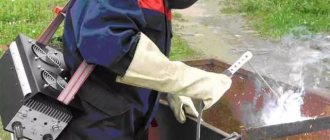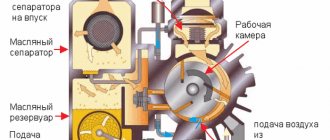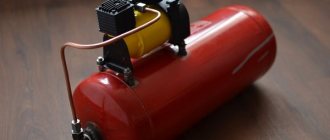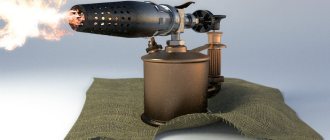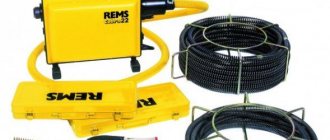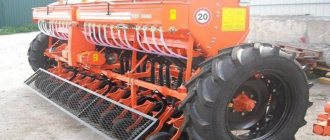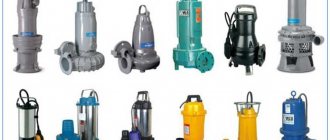Operating principle and design of the hydraulic pump
In its traditional form, the hydraulic pump has a very simple piston-piston design. Such a device is much less susceptible to damage, is highly stable and allows the pump to be used when working with liquids, both from a reservoir and from a natural source.
The special operating principle of the hydraulic pump makes it quite productive. Elements inside the pumps convert the fluid's energy from mechanical to hydraulic. When in use, the pump motor generates the torque necessary to generate flow or pressure.
The pump design contains two chambers. One of them is responsible for discharge, and the second is responsible for suction. Both chambers are isolated from each other, and liquid passes between them. As soon as the discharge chamber becomes completely filled, the piston begins to work. The suction pipes are responsible for the absorption of liquid, which remove it in the direction required for work.
Double acting hydraulic system
A double-acting hydraulic system requires a standard adapter as well as a pump. In this case, the coupling half is used from the BRR series. It should also be noted that the rod can be connected to the system, and this is done to return the stroke. By default, it is assumed that there is one hydraulic pipe, but several can be connected. In order to connect the pump to the actuator, a special hydraulic lock is used. It is installed on two connectors at once. In this case, the pressure can jump to 3 MPa.
In this case, you should constantly monitor the pressure gauge readings. After installing the hydraulic lock, you need to tighten all the bolts and check the rod for functionality. Additionally, it should be noted that protective bushings in this system can only be used of the UGZ class. This is due to the fact that it is necessary to connect to the actuator with exactly two connectors.
Types of hydraulic pumps - classification of units on the market
According to design features, purpose and areas of operation, there are the following types of hydraulic pumps:
- Manual ones are inexpensive devices that work on the principle of displacement. A hand pump does not have high performance and can only cope with the simplest tasks in the household;
- Radial piston - their design includes an eccentric shaft or rotor. The entire piston group of such units is located inside their housings. Among the advantages of these systems, low noise levels and the ability to operate under high pressure conditions of up to 100 Pa should be highlighted. Among the disadvantages are the large dimensions;
- Axial piston - these pumps use a plunger displacement system. This type includes inclined and straight pumps. Among the advantages of such systems is the highest performance among all types of equipment. Disadvantage: very high cost;
- Gear - this type includes units with electric drive. The main hydraulic element is made of two gears, which, as a result of clutch, squeeze out fluid. Pumps of this type are not capable of operating under high pressure conditions, but their cost is much lower than the units of the two previous types.
Most modern water pumps are often used in large farms. This allows owners to save a lot of time when collecting and pumping clean and recycled liquid.
Diagram of a hand pump for pumping out oil
To pump out large quantities of oil, a durable hydraulic cylinder is required (a diagram of a manual hydraulic pump is shown below). As a rule, it is reinforced with a small support. As a result, it is possible to secure it more tightly. Additionally, bolts are used for this.
Among other things, the hand pump is equipped with a hydraulic tube. Its main task is to supply pressure to the cylinder. For this purpose, a tee is installed in the device. It is mounted on a special cushion, which is fixed on a washer. It is also secured with nuts. A rubber band is used for the holder in the hand pump. In this case, the fitting is located at the very bottom.
How to choose a hydraulic pump - expert advice
When choosing a pressure pump, in addition to price, pressure inside the system and operating conditions, you should pay attention to a number of the following factors:
- System motor power;
- Compliance of the design with further conditions of use;
- Maximum operating pressure;
- Capacity of working chambers;
- The maximum permissible viscosity of the liquid that will be pumped;
- The force required to bring the system into operation;
- Ease of operation;
- Weight and dimensions of equipment.
Each characteristic on the list plays a very important role. By carefully studying all the factors, you can purchase a suitable electro-hydraulic pump that will perform its functions well and quickly.
How is it built?
The standard manual (hydraulic) pump has a simple device. There is a test hose located at the bottom of the housing. It is attached to the mechanism through a special hole using clamps. There is a valve higher up in the hand pump that controls the pressure. By turning it clockwise, you can adjust the pumping force.
There is a plug for filling the tank. Below it is a small port, which is designed to connect to the general system. The mechanism also has a separate reservoir with a pipe for liquid. The hydraulic cylinder is connected to the hand pump using a threaded method. To adjust the valve intensity, manufacturers install special regulators. With their help you can easily change the pressure. In this case, the pump handle is installed separately, which is secured with a plug.
NSh 10 – description of a popular model
The unit of this model is successfully used in the automotive industry, in the manufacture of tractors and other types of heavy agricultural equipment. It is often included in the design of domestic loaders and excavators created on the basis of tractors of the 1.4 tf class.
Among the main technical characteristics of the pump, the following should be highlighted:
- Working capacity – 10 cm3;
- Rotation speed – 3600 rpm;
- Maximum productivity – 11.5 l./min.;
- The nominal outlet pressure is 16 MPa;
- The maximum permissible pressure is 21 MPa;
- Weight – 2 kg;
- Efficiency indicator – 0.95.
Due to its high reliability and excellent build quality, this pneumohydraulic pump has proven itself well in industry. It rarely needs repairs and does not require regular maintenance.
Gear pumps
Fig 2 Gear pump
A type of rotary hydraulic pumps should be called gear pumps. They are based on two small gears that constantly rotate. Its advantages include high performance, rotation speed that reaches 5000 rpm and a relatively low price. The disadvantage is high pressure pulsation.
They are divided into:
• External gear pumps
• Internal gear pumps.
• A special case of internal gear pumps are gerotor pumps.
Technical characteristics of the model NSh 32
Most excavators are equipped with these pumps. Moreover, more than half of the excavators created on the basis of MTZ and YuTZ tractors have a pump mounted on the front circuit. This guarantees improved performance of the machine with bucket and bulldozer. Older chain tractors were equipped with NSh 32 pumps to ensure the operation of the bulldozer cylinders and supports.
For tractors created on the basis of MTZ, pumping equipment is responsible for the operation of the bucket, grab and boom.
Pump specifications include:
- Working volume – 31.7 cm3;
- The rated speed is 3 thousand rpm;
- Performance indicator at 1200 rpm. – 36 l./min.;
- Nominal outlet pressure – 16 MPa;
- The maximum outlet pressure is 21 MPa;
- Pump weight – 5 kg;
- Efficiency indicator – 0.95.
The unit of this model is characterized by high reliability and long service life. Thanks to this, it is actively purchased by foreign manufacturers of agricultural machinery.
Equipment brands NSh and NP - description of models
On the market you can find a large selection of hydraulic pumps produced by different brands, but most often users use NSh and NP equipment. Below we will find out the reason for the popularity of these models.
Pump NSh-32
The gear hydraulic pump in the 32nd modification is designed to maintain right and left rotation of the shaft. The device can be installed on various tractors, combines, bulldozers, and dump trucks. It is often used in the construction of motor graders, loaders and excavators.
The NSh-32 hydraulic pump has a long service life. Its motor life is 10,000 hours or 3 years of regular use. The device is produced in Ukraine and Belarus.
Pump NSh-10
Models of this brand are designed for operation under increased loads. At the same time, they are quite easy to use and do not require specialized maintenance.
Hydraulic pump NSh-10 consists of:
- sealed aluminum housing;
- two gears almost adjacent to each other;
- bearings located next to the side parts of the gears;
- pressed sealing collar;
- back cover.
The tenth modification of the hydraulic pump is popular among users due to its high efficiency. This characteristic of the model reaches 0.8. The weight of the device is from 1.9 to 2.5 kg.
Pump NSh-50
The hydraulic pump in the 50th modification is designed for installation and operation in systems operating under pressure up to 160 kgf/cm2. It can be mounted in the design of road, construction and agricultural equipment.
The main advantages of the NSh-50 model include the simplicity of the factory design and ease of maintenance. Hydraulic pump repair can be performed by anyone who understands the operating principle of the hydraulic system.
Today on the market you can find NSh-50 models from different manufacturers. Structurally, they are interchangeable, however, when purchasing a pump, you need to take into account that models from different companies differ in size.
The NSh-50 hydraulic pump is popular among users due to its high performance. It is 55.97 l/min at a shaft rotation speed of 1200 rpm.
Pump NP-90
Axial piston hydraulic pumps NP-90 are designed for operation in volumetric hydraulic drives operating in a closed circuit. Each model is equipped with an inclined disk that changes the direction of flow of the working fluid.
The NP-90 hydraulic pump is easy to operate and has fairly modest dimensions. It pumps liquid in direct proportion to the speed of rotation of the rotor.
The volume of the working chamber of the unit is 90 cm3. If necessary, it can be supplemented with another similar device.
NSh 50 – areas of application of the pump
This automatic pump is successfully used in the construction of road, agricultural and machine tools. It is often used in hydraulic systems operating at a pressure of 155 kgf/cm2. This model is currently produced by several manufacturers.
The products of each of them have many similarities in design and performance, but differ in size.
Pump specifications include:
- Working volume – 49 cm3;
- The rated speed is 3 thousand rpm;
- Rotation performance 1200 rpm. – 56 l./min.;
- The nominal outlet pressure value is 16 MPa;
- The maximum outlet pressure indicator is 21 MPa;
- Weight – 8 kg;
- Efficiency indicator – 0.95.
A hydraulic pump station equipped with such a unit will last a long time, regardless of the conditions and type of liquid.
High pressure pump
A distinctive feature of high pressure pumps is their durable hose. In this case, the valve is installed as a plunger type. It is attached to the body with two bolts. So the connection is quite rigid. There is a large lever to adjust the operation of the device. The rear cover of the hand pump is secured using a clamping rod. It, in turn, is connected to an air reservoir.
The manual hydraulic high-pressure pump “Hansa-014T” is capable of withstanding a maximum load of up to 700 bar. However, it is intended exclusively for mineral oil. It is also allowed to use distilled water. Adjusting this modification is quite simple. For this purpose, the sample is equipped with a rotary valve. Additionally, a durable hose 1 meter long should be noted.
In turn, the manual hydraulic high-pressure pump “Khansa-015T” is a more powerful prototype. It can withstand a maximum load of 800 bar.
An additional nut is provided to protect the system. The tank of this model is made of aluminum. In this case, the central rod is made of copper. It should also be noted that the entire body is made of stainless steel. In this case, the handle is rubberized and very comfortable, and this unit weighs about 25 kg when assembled.
NP 90 pumps - purpose and characteristics
This unit belongs to axial piston pumps with an adjustment function. It is used when operating large hydraulic drives that include a motor. Units of this modification are widely used in the creation of combines, road compactors and concrete mixer trucks.
NP 90 pumps are easy to operate and small in size. They are durable, do not require special care and are not afraid of extreme conditions. Among the technical characteristics of the pumps, the following should be highlighted:
- The maximum working volume is 89;
- Charge pump capacity – 18.06;
- The nominal outlet pressure indicator is 26.5 MPa;
- The maximum outlet pressure value is 35.8 MPa;
- The maximum speed is 2590 rpm;
- Empty weight – 78 kg.
This model is in wide demand due to its excellent configuration and high build quality. It is well balanced, does not require frequent repairs and is much cheaper than its imported counterparts.
How do hand pumps operate from a station?
The hand pump can only be connected to the station using an adapter of the ШП series. In this case, the standard connection diagram provides for the presence of a drain pipe. It is produced with the “T” marking. Additionally, you will need a valve that will regulate the pressure. The coupling half of the device is directly attached to the second hose. In this case, the central rod is not used. This is due to the lack of a hydraulic lock.
Ultimately, the system must be closed on the actuator. In order to check the functionality of the pump, the valve should be fully screwed in until it stops. Next, the actuator is turned on. At this time, the pressure gauge should not show pressure. If any problems occur, you should completely check the circuit for integrity.
Types of hydraulic pumps
Manufacturers offer several types of devices for collecting water from aquifers:
Piston hand pump
Traditionally, this particular device is found in the areas. It effectively copes with the task of collecting liquid from shallow depths of up to 7-8 m. It is based on a working piston moving along a cylinder.
The exit of liquid is blocked through the use of check valves.
It is installed 1 m above ground level. Due to the mechanical control of the lever, the manual pump pump drives the piston. When moving in one direction, liquid is taken into the cavity; when moving in the opposite direction, a portion of water is sent upward. This is how pumping occurs.
Rod hand pump
A hand pump for water is used in areas for sampling from lower horizons of 7-30 m. The principle is similar to the operation of a piston pump, but the length of the “piston” (plunger) is much longer and resembles a drill rod.
Due to its significant dimensions, the plunger apparatus creates a vacuum at a low depth and supplies liquid upward through the inlet pipe.
Gate (rotary-plate)
It has low power and is often used for pumping liquids from barrels or open reservoirs. Outwardly they resemble a tube, at the end of which a pump with a rotor is mounted. It has high mobility unlike other varieties.
If necessary, it can be used in various operations, since it is light in weight, and a regular hose is used for sampling.
Membrane
The device is capable of pumping out even contaminated liquid. The design uses self-cleaning ball valves. This solution allows us to minimize the possibility of jamming of the mechanism. A special feature of such models is the absence of quickly wearing or rubbing parts. The body is made of cast gray cast iron.
When choosing a specific instance, you need to pay attention to the following models:
Hand pump for water at the dacha BSK
It is used without modernization at a horizon not lower than 6 m. When installing an additional check valve, it is capable of sampling from a 9-meter level. Aesthetic appearance allows you to decorate any area. For fastening, the structure has a flange that allows you to fix the device on a pipe or platform. Possibility of installation to a vertical surface is provided. The estimated cost is 4800 rubles.
Hand pump for water at the dacha D-40
D40, Membrane (diaphragm)
Membrane type device. Capable of self-cleaning from possible contamination. Effectively copes with pumping liquids of any type. The cost is 6300 rubles.
Hand pump for water at the dacha RNP 1.3/30
Used in liquid media, including contaminated liquid. Capable of passing contaminants up to 1 mm in diameter. The maximum maximum concentration of pollution should not exceed 30 g/m3. Operates at a horizon of up to 5 m. The body is made of cast iron. The stroke type is double-sided, which increases the performance of the device. The cost is 16,200 rubles.
Hand pump for water at the dacha “K” (impeller)
Used for depths up to 9 m. The design includes 4 valves and a wing. Working with the handle, the operator alternately opens and closes the valves through which the liquid is supplied. The cost of the product in a steel case is 3,100 rubles.
A manual pump for pumping should be in any household. This small alternative device will successfully replace the pumping station in the event of an unauthorized power outage. It will also be useful in case of failure of pumping equipment. This will make it possible to pump up the volume, albeit in a limited quantity, but not be left without it at all.
For automated pumps, the rapid change of on/off cycles is critical - they fail within a short time. When you need a small amount, it is better to use hand pumps.
Advantages and types of hand pumps
The speed of pumping water mechanically and the resulting volume are significantly inferior to electrical analogues, however, the technique has a right to exist, as it has its advantages. The main advantage is autonomy, which minimizes risks. It is appropriate to use the technique if any condition exists:
- relatively low need for daily water volume;
- for a homemade shallow well or a well located on your own personal plot;
- a hand pump for pumping out water is used as an emergency source in case of a power outage at the main water intake device;
- for public use when there is no desire to use a traditional chain, crankshaft and bucket;
- if there is no electricity connection at the site.
In some cases, a mechanical piston unit in working form is used as a decorative element, complementing the created exotic surroundings of the site.
Such a unit can also become a decoration for the site.
Separately, the sites require fecal pumping units, which are used for pumping contaminated media, including for cleaning sewer pits, cellars and lower floors during flooding. The design includes a grinder designed for a certain particle size, which crushes foreign impurities during operation.
Operating the device has its advantages:
- quick installation;
- repairable units;
- low maintenance;
- unified components;
- long uninterrupted service life;
- minimum cost of the finished product.
The disadvantage in some situations is the need to apply physical force to pump. This makes the device inconvenient for use by elderly, weak people and children. The result will also be low productivity.
Axial piston pumps: design, principle of operation, pros and cons
An axial piston pump is a technical device that belongs to the category of hydraulic machines, the mechanical energy of the working body of which is converted into the energy of a moving fluid flow. If such machines perform the opposite action (in other words, the energy of the fluid flow is converted into mechanical energy), they are called hydraulic motors. Both hydraulic motors and hydraulic pumps began to be used quite a long time ago, and today they are actively used almost everywhere.
HP hydraulic hand pump: types and characteristics
HP series manual pumps
The HP series includes single-stage and two-stage models with oil in the reservoir, ready for use. The operating pressure in all models is maximum 700 bar.
Note. This series includes hydraulic hand pumps that are suitable for use with both hydraulic tools and single acting cylinders.
HP models are used when a small independent high pressure source is needed:
- HP have a reliable design.
- Low force on the handle makes all stages of work easier.
- There are 1 or 2 speed models.
- Oil capacity up to 5 liters.
- Pressure 700 bar.
Pressure for two-stage models is 14 bar.
Aluminum manual models
Aluminum Pump Series
Aluminum models are also available in single-stage and two-stage versions, with a maximum operating pressure of 700 bar. Designed for use with single and double acting cylinders.
HP aluminum series:
- It is light in weight.
- Durable design.
- Minimal effort on the handle.
- Convenient work.
- Two-stage models.
- There is a choice of control valve.
There is a pressure relief valve.

